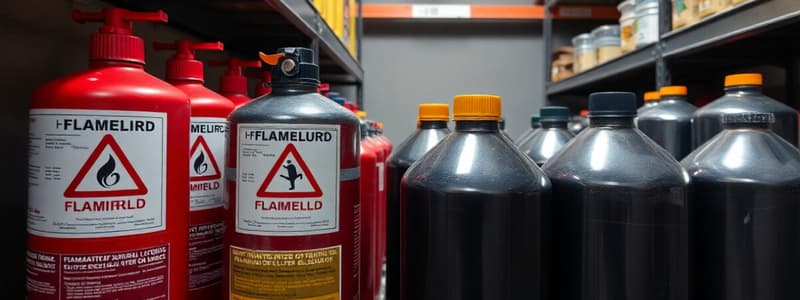Podcast
Questions and Answers
What is the main purpose of bonding when transferring flammable liquids?
What is the main purpose of bonding when transferring flammable liquids?
- To make sure both containers are electrically neutral to each other (correct)
- To cool down the liquid during transfer
- To ensure containers are securely sealed
- To prevent the accumulation of pressure in containers
How far away should flammable materials be stored from ignition sources?
How far away should flammable materials be stored from ignition sources?
- 10 feet
- 50 feet
- 25 feet (correct)
- 100 feet
What is the requirement for dispensing Category 1 or 2 flammable liquids?
What is the requirement for dispensing Category 1 or 2 flammable liquids?
- Containers need to be hermetically sealed
- Both the nozzle and container must be made of glass
- The nozzle and container must be electrically interconnected (correct)
- They must be dispensed in a well-ventilated area
What does grounding refer to in the context of flammable liquids?
What does grounding refer to in the context of flammable liquids?
Which of the following standards addresses bonding and grounding for flammable liquids?
Which of the following standards addresses bonding and grounding for flammable liquids?
What is the maximum allowed quantity of Category 1 flammable liquid in a fire area outside protected storage?
What is the maximum allowed quantity of Category 1 flammable liquid in a fire area outside protected storage?
Where is flammable liquid storage prohibited?
Where is flammable liquid storage prohibited?
Which of the following is an exemption for the incidental storage of flammable liquids?
Which of the following is an exemption for the incidental storage of flammable liquids?
What is the flash point criterion for Category 4 flammable liquids?
What is the flash point criterion for Category 4 flammable liquids?
What determines the allowable quantities of flammable liquids in a storage area?
What determines the allowable quantities of flammable liquids in a storage area?
What volume of a Category 2, 3, or 4 flammable liquid is allowed in a single portable tank?
What volume of a Category 2, 3, or 4 flammable liquid is allowed in a single portable tank?
Which of the following structures is NOT suitable for storing flammable liquids?
Which of the following structures is NOT suitable for storing flammable liquids?
What is the minimum required ventilation capacity for an inside storage room?
What is the minimum required ventilation capacity for an inside storage room?
Which of the following is NOT a requirement for the storage room design?
Which of the following is NOT a requirement for the storage room design?
What is the maximum size for a storage room with 2 hours fire resistance and allowed fire protection?
What is the maximum size for a storage room with 2 hours fire resistance and allowed fire protection?
What is the minimum aisle width required in an inside storage room?
What is the minimum aisle width required in an inside storage room?
What happens when the allowable quantities of flammable liquids are exceeded in an inside storage room?
What happens when the allowable quantities of flammable liquids are exceeded in an inside storage room?
What rating is required for forklift trucks used in flammable environment storage rooms?
What rating is required for forklift trucks used in flammable environment storage rooms?
When containers hold 30 gallons or more, what is prohibited in indoor storage rooms?
When containers hold 30 gallons or more, what is prohibited in indoor storage rooms?
According to OSHA's regulations, what is the fire-resistive rating that allows for a maximum of 10 gallons per square foot?
According to OSHA's regulations, what is the fire-resistive rating that allows for a maximum of 10 gallons per square foot?
Which of the following components is designed to fail in case of an explosion?
Which of the following components is designed to fail in case of an explosion?
What should be incorporated into an inside storage room to handle spills?
What should be incorporated into an inside storage room to handle spills?
What is the maximum allowable size for glass containers holding Category 3 flammable liquids?
What is the maximum allowable size for glass containers holding Category 3 flammable liquids?
Which type of container has the smallest maximum allowable size for Category 1 flammable liquids?
Which type of container has the smallest maximum allowable size for Category 1 flammable liquids?
What is the requirement for the doorsill height of compliant flammable storage cabinets?
What is the requirement for the doorsill height of compliant flammable storage cabinets?
Which of the following does not require venting for fire protection purposes according to NFPA 30?
Which of the following does not require venting for fire protection purposes according to NFPA 30?
For which category of flammable liquids do metal containers (other than DOT drums) have a maximum size of 5 gallons?
For which category of flammable liquids do metal containers (other than DOT drums) have a maximum size of 5 gallons?
What is NOT an exemption to the maximum allowable size for flammable containers as stated in OSHA regulations?
What is NOT an exemption to the maximum allowable size for flammable containers as stated in OSHA regulations?
What gauge sheet iron must metal cabinets be constructed from according to OSHA requirements?
What gauge sheet iron must metal cabinets be constructed from according to OSHA requirements?
What is the maximum allowable size for safety cans holding Category 4 flammable liquids?
What is the maximum allowable size for safety cans holding Category 4 flammable liquids?
What should be placed in the bung of non-vented storage cabinets?
What should be placed in the bung of non-vented storage cabinets?
What is the maximum increase in allowable quantities of flammable liquids if they are stored in approved storage cabinets?
What is the maximum increase in allowable quantities of flammable liquids if they are stored in approved storage cabinets?
What is required to be placed outside indoor storage rooms according to OSHA?
What is required to be placed outside indoor storage rooms according to OSHA?
How far from a Category 1, 2, or 3 flammable liquid storage area must an extinguisher be located?
How far from a Category 1, 2, or 3 flammable liquid storage area must an extinguisher be located?
What is the minimum required space between buildings and flammable liquid containers?
What is the minimum required space between buildings and flammable liquid containers?
Which of the following chemicals should not be stored with flammable liquids due to compatibility issues?
Which of the following chemicals should not be stored with flammable liquids due to compatibility issues?
What type of materials are susceptible to spontaneous heating and/or explosions?
What type of materials are susceptible to spontaneous heating and/or explosions?
What is a necessary feature for an outdoor storage area of flammable liquids?
What is a necessary feature for an outdoor storage area of flammable liquids?
Which of the following acids is identified as a common incompatible chemical with flammables?
Which of the following acids is identified as a common incompatible chemical with flammables?
What feature of outdoor storage areas is necessary to avoid spills reaching buildings?
What feature of outdoor storage areas is necessary to avoid spills reaching buildings?
Why should flammable liquids not be stored with oxidizing agents?
Why should flammable liquids not be stored with oxidizing agents?
Flashcards
Incidental Storage
Incidental Storage
A specific area within a facility where the use and handling of flammable liquids is only incidental to the main business operation. Examples include automobile assembly, construction of electronic equipment, and furniture manufacturing.
Flammable Liquid Storage Containers
Flammable Liquid Storage Containers
Flammable liquids must be stored in a closed container, such as a tank or a container that complies with OSHA and NFPA standards.
Flammable Storage Cabinet
Flammable Storage Cabinet
A storage cabinet specifically designed to store flammable liquids, providing fire protection.
Inside Storage Room
Inside Storage Room
Signup and view all the flashcards
Flammable Storage Warehouse
Flammable Storage Warehouse
Signup and view all the flashcards
Category of Flammable Liquids
Category of Flammable Liquids
Signup and view all the flashcards
Flash Point
Flash Point
Signup and view all the flashcards
Grounding
Grounding
Signup and view all the flashcards
Bonding
Bonding
Signup and view all the flashcards
Electrical Interconnection
Electrical Interconnection
Signup and view all the flashcards
Flammable Liquids
Flammable Liquids
Signup and view all the flashcards
29 CFR 1910.106: Flammable Liquid Container Sizes
29 CFR 1910.106: Flammable Liquid Container Sizes
Signup and view all the flashcards
Flammable Storage Cabinet Labeling
Flammable Storage Cabinet Labeling
Signup and view all the flashcards
Flammable Storage Cabinet Construction
Flammable Storage Cabinet Construction
Signup and view all the flashcards
Flammable Storage Rooms
Flammable Storage Rooms
Signup and view all the flashcards
Fire Extinguisher Placement: Indoor Storage
Fire Extinguisher Placement: Indoor Storage
Signup and view all the flashcards
Fire Extinguisher Placement: Outdoor Storage
Fire Extinguisher Placement: Outdoor Storage
Signup and view all the flashcards
Flammable Liquid Storage Limits: Outdoor
Flammable Liquid Storage Limits: Outdoor
Signup and view all the flashcards
Outdoor Spill Prevention
Outdoor Spill Prevention
Signup and view all the flashcards
Incompatible Storage: Oxidizing Agents
Incompatible Storage: Oxidizing Agents
Signup and view all the flashcards
Incompatible Storage: Corrosive Chemicals
Incompatible Storage: Corrosive Chemicals
Signup and view all the flashcards
Incompatible Storage: Reactive Materials
Incompatible Storage: Reactive Materials
Signup and view all the flashcards
Incompatible Storage: Air/Moisture Reactive Materials
Incompatible Storage: Air/Moisture Reactive Materials
Signup and view all the flashcards
Ventilation System
Ventilation System
Signup and view all the flashcards
Aisle Space
Aisle Space
Signup and view all the flashcards
Blowout Panels
Blowout Panels
Signup and view all the flashcards
Spill Containment
Spill Containment
Signup and view all the flashcards
Fire Resistance
Fire Resistance
Signup and view all the flashcards
29 CFR 1910.106
29 CFR 1910.106
Signup and view all the flashcards
Total Allowable Quantities
Total Allowable Quantities
Signup and view all the flashcards
Forklift for Flammable Environments
Forklift for Flammable Environments
Signup and view all the flashcards
3-Foot Wide Aisle
3-Foot Wide Aisle
Signup and view all the flashcards
Study Notes
Flammable Liquids Storage
- Flammable liquids must be stored in designated cabinets, rooms, or warehouses.
- Storage amounts depend on the type of business, room size, construction, fire resistance, and fire protection.
- Storage is prohibited in some areas (e.g., office areas), except for maintenance or operating equipment.
- "Incidental storage" is an exception for operations where handling flammable liquids is secondary to the main business activity.
- Examples of incidental storage include automobile assembly and electronics manufacturing.
- OSHA allows up to 25 gallons of Category 1 flammable liquids and 120 gallons of Category 2, 3, or 4 liquids in an area outside protected storage.
- It allows up to 660 gallons of Category 2, 3, or 4 flammable liquids in a single portable tank. Local fire marshal or insurance carrier rules may be stricter.
- OSHA categorizes flammable materials in different categories based on flash points and boiling points.
Container Sizes
- Table B.6.1 from 29 CFR 1910.1200 outlines criteria for flammable liquids.
- OSHA specifies maximum container sizes for each category of flammable materials.
- Container types include glass, metal (except DOT drums), and safety cans.
- Maximum sizes (in gallons) vary by container type and flammable liquid category.
- Container exemptions exist for medicines, beverages, food products, cosmetics, and common consumer items packaged according to standard practices.
Storage Cabinets and Rooms
- Flammable materials must utilize approved fireproof cabinets or storage rooms, with specific criteria set by 29 CFR 1910.106.
- Cabinets must be labeled "FLAMMABLE – KEEP FIRE AWAY".
- Metal cabinets must have at least 18-gauge sheet iron, double walls, and a 1.5-inch air space.
- Doors must be at least 2 inches above the cabinet bottom.
- Venting of flammable storage cabinets is allowed, but not always required. If not vented, appropriate bungs must be in place.
- OSHA doesn't require grounding of cabinets. NFPA 77 does, and local fire codes/insurance companies may also require grounding.
Storage Rooms
- For larger quantities of flammables, special rooms designed for storage are necessary.
- Key features for these rooms include electrically classified fixtures and wiring; high and low-point ventilation; fire-resistant walls and ceilings; blowout panels; methods for capturing spills; and 6 air changes per hour ventilation.
- Aisles at least 3 feet wide must be present for room accessibility during an emergency.
- Storage of containers exceeding 30 gallons in a single indoor storage room is not allowed.
- Allowable quantities of flammable liquids inside storage rooms depend on the fire resistance rating of the room.
Outside Storage
- Outdoor storage areas for flammable liquids require adequate fire controls.
- These include working hoses, portable fire extinguishers, and fire control devices.
- At least one portable fire extinguisher with a 12-B rating must be present, within 10 feet of the room door and 10-25 feet from the storage area.
- Up to 1,100 gallons of flammable liquids are permitted near a building, separated by a 10-foot space.
Flammable Liquid Compatibility
- Flammables should not be stored with oxidizing agents (chlorates, nitrates, perchlorates, permanganates, peroxides).
- Flammables must also not be stored with corrosive materials (acids, bases).
- Spontaneous heating/explosion hazards should be avoided.
- Do not store flammables near heat sources.
Electrical Protection
- Be aware of the hazards of electricity around flammables.
- Flammable materials must be at least 25 feet from ignition sources unless separated by a fire resistant barrier.
- Wire and electrical fixtures around flammable liquids need to meet specifications in §1910 or National Electrical Code.
- Containers of Category 1, 2, or 3 flammables with flash points below 100°F (37.8°C) require electrical interconnection (bonding) during transfer steps.
- Grounding and bonding of containers are essential to prevent sparks.
Hot Work
- Hot work (welding, cutting, power tools) requires supervision by responsible personnel.
- "Hot work" permits must be obtained before starting work in areas with flammable liquids.
- The area must be cleared of combustible materials.
- Fire watch is needed to monitor for potential issues.
Studying That Suits You
Use AI to generate personalized quizzes and flashcards to suit your learning preferences.




